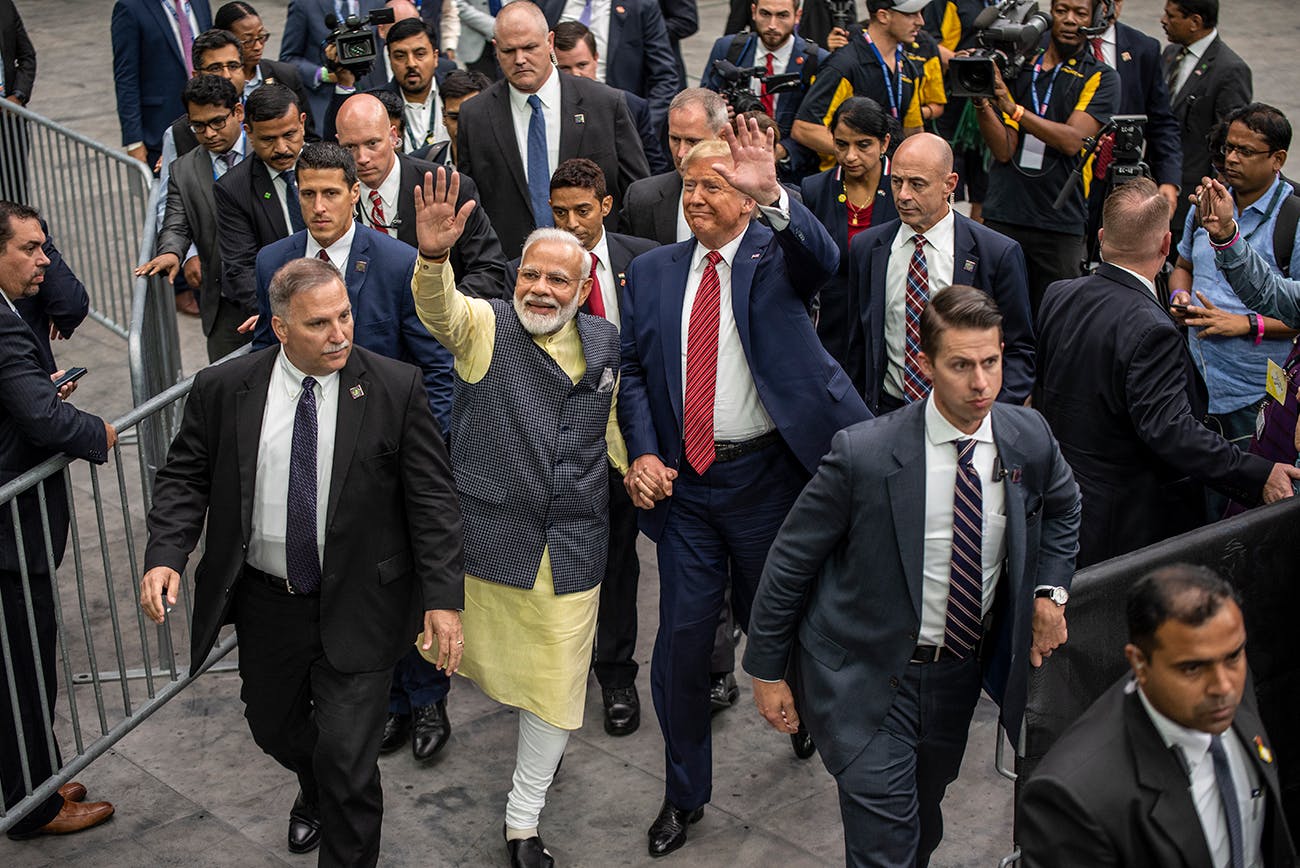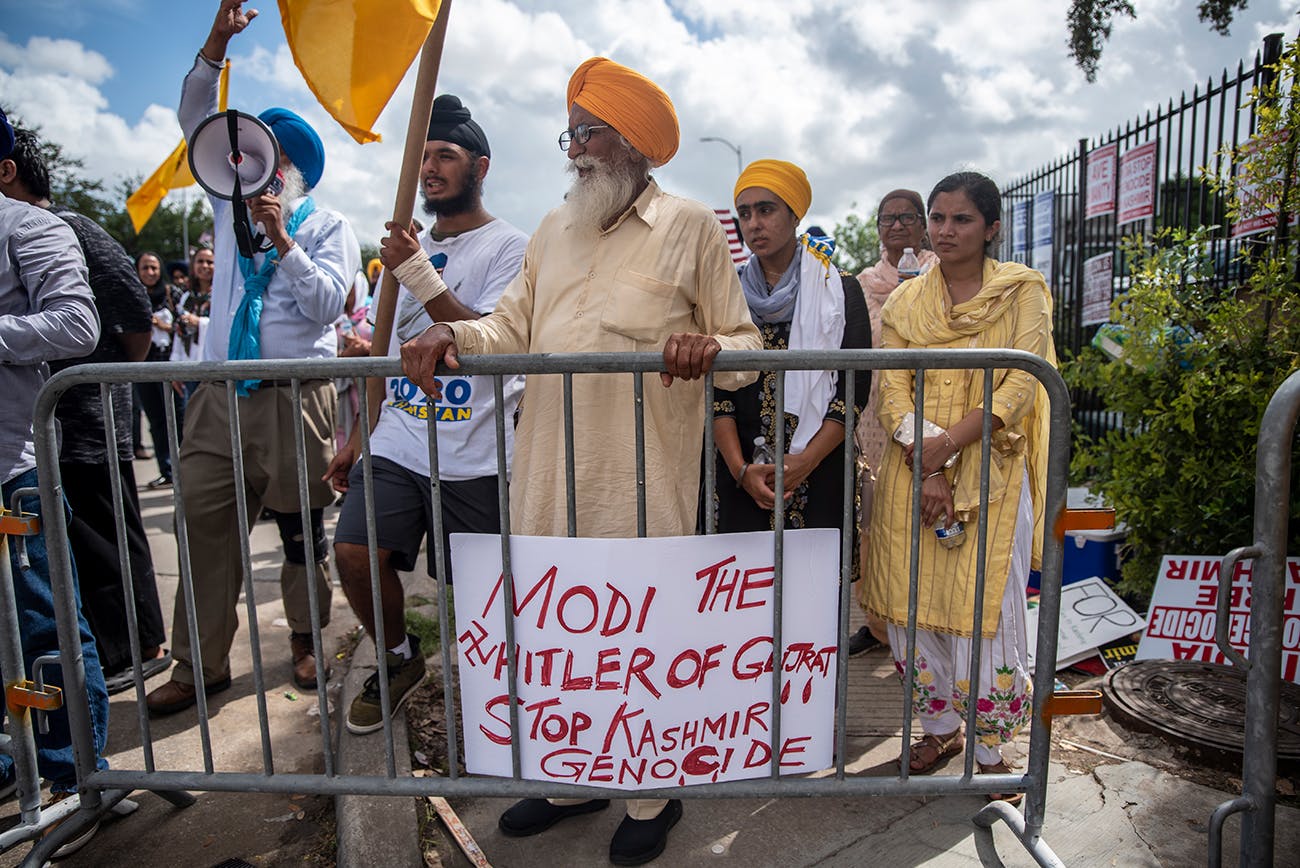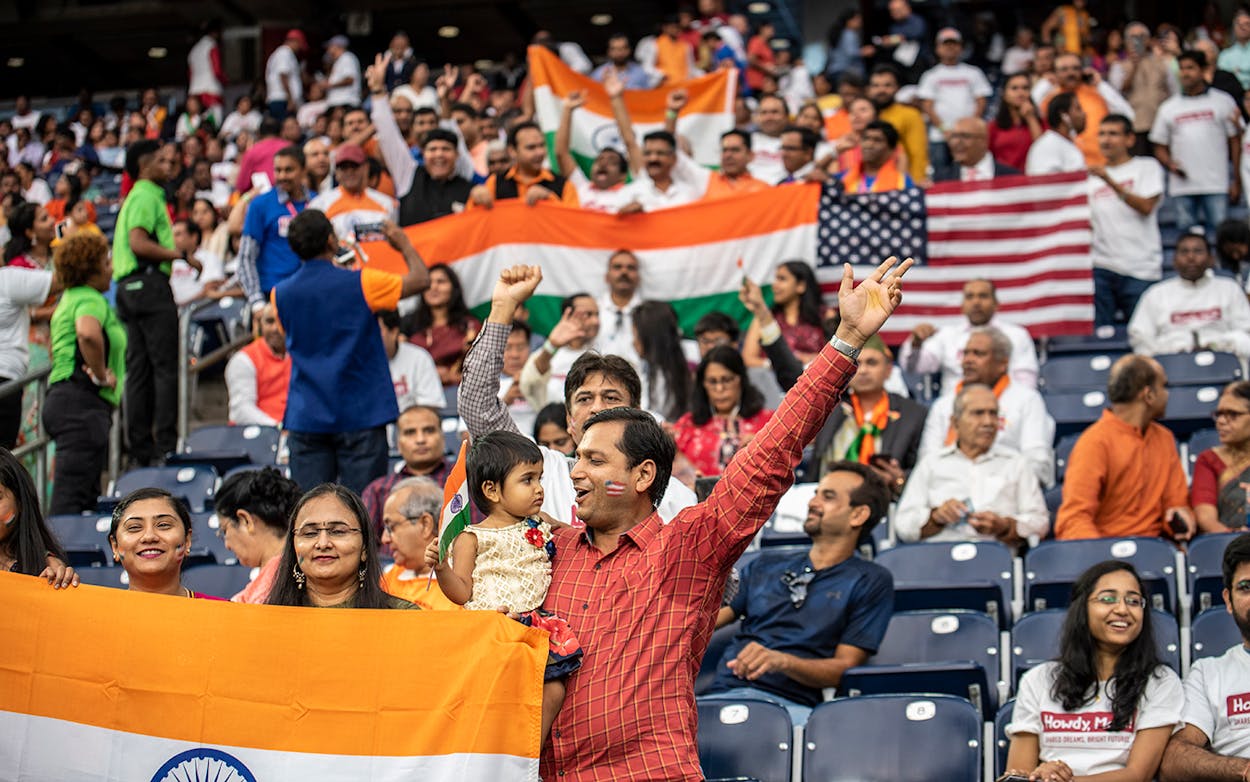Before the joint rally this weekend with President Donald Trump and Indian Prime Minister Narendra Modi, the largest political event to take place at NRG Stadium, the home of the Houston Texans, was probably the prayer rally that helped launch Rick Perry’s 2012 presidential campaign. Named “The Response,” it drew some 30,000 people, whose supplications were credited by some for having ended the state’s drought. That feels like a century ago, not least because it now seems quaint that anyone could gather in Houston and pray for rain.
But a lot of things have changed. Back then Modi, then the longtime chief minister of the state of Gujarat, couldn’t set foot in the United States. In 2002, an extraordinary wave of anti-Muslim communal violence swallowed his state—massacres, mass rape, arson, looting. Between one thousand and two thousand people were killed, and as many as 150,000 were displaced. Modi belongs to a Hindu nationalist party, and his government was widely held by observers to have stoked the violence, sponsoring what was essentially a government pogrom. In 2005, he was barred from entering the country.
But in 2014, Modi became his country’s leader, and two years later Trump became his. (When it rains, it pours.) They became the two most prominent members of a loose club of international leaders of democratic countries, right-wing and ethno-nationalist, known mostly by their last names—Bolsonaro, Orbán, Erdogan. On Sunday, the two got to party together at NRG, at what was surely one of the strangest events ever held by a foreign leader in the United States. A massive stage at one end of the field emitted smoke, electronic music, and strobe lights for hours as a crowd of mostly Indian Americans waited for the show to start.
The event was sponsored by the Texas India Forum, which reported they were anticipating a packed house of some 50,000 people. (Though there were a noticeable number of empty seats in the higher sections.) But really, there were two parallel events, one remarkably wholesome and the other unsettling.

The first was how most people in the audience doubtless experienced it—as a celebration of the strength of Houston’s Indian diaspora. It’s a supreme compliment that the leader of a country of almost 1.4 billion people should take the time to come here and celebrate. If the presence of Indian Americans in Houston was once novel, it’s now impossible to imagine the city without them.
The cultural program and video presentations that filled the first few hours of the rally, produced by the Texas India Forum, were completely devoid of politics and mixed dance and music from various traditions with stories about the common struggles of first and second generation immigrants in the United States. A prolonged segment told the story of “Sonia” from Beaumont, the only Indian in her high school and captain of a Rangerettes-type drill team, who goes to the University of Houston and suddenly meets members of a “competitive Bollywood fusion dance team.”
Skits between dances tell the story: She learns more about the cultural traditions of the motherland. A phone call with her mother soothes her confusion. “You will always be Indian and American,” her mother says. “It’s time for you to connect with your culture in your own way.” A voiceover finishes the routine. “Here’s our Sonia. Brown and proud and red white and blue.”
Such was the mood of the celebration that retiring Congressman Pete Olson, who in 2018 called his general election opponent Sri Kulkarni an “Indo-American carpetbagger,” appeared on stage in traditional Indian dress, bowing to shake Modi’s hand. If that’s not a sign an immigrant community has “made it,” nothing is.
The unsettling part came later, when the politics started, but it was foreshadowed on the southwest side of the stadium before the rally began. A tightly packed and fenced-in group of protesters shouted “Modi Killer” and carried signs that said “Free Kashmir,” the divided territory claimed by both India and Pakistan. Today, the Line of Control ran through the intersection of Kirby Drive and Westridge Street, manned by Houston police. As rally attendees filtered in and out, they shouted “Modi! Modi!” at the protesters, or stopped to flip them the bird.

India has long maintained a proud and functioning democracy despite being composed of a bewildering array of ethnicities, religions, and languages. Modi’s party, the Bharatiya Janata Party or BJP, favors the idea of India as a nation for Hindus. It has close links with a nationalist, paramilitary organization called the Rashtriya Swayamsevak Sangh, whose leaders drew inspiration from Adolf Hitler and Benito Mussolini in the thirties. Modi is a former member, as was Mahatma Gandhi’s assassin.
Since his overwhelming reelection earlier this year, Modi is putting more of his stamp on the country. In Indian Kashmir, the country’s only state with a majority Muslim population, Modi recently dissolved the elected local government entirely, imposed martial law, arrested many prominent citizens, and cut off all communications. In the state of Assam, the BJP government is moving to declare millions of predominantly Muslim residents illegal aliens, subjecting them to capricious “Foreigners Tribunals” if they want to stay, and deporting the rest.
That’s the background to Modi’s visit and his embrace of Trump. The two men came together at quite an important moment. Modi has big plans and is facing international criticism, and could use a vote of confidence from the president of the United States.
What does Trump get out of the deal? What do you get for a man who has everything? Affirmation. You take a huge crowd—almost certainly bigger than any rally the Trump campaign ever did—in a place where Trump needs help, politically. You invite the president on stage, and you praise him. I mean, you really praise him.
“He needs no introduction,” Modi said. “His name is familiar to every person on the planet. His name comes up in almost every conversation in the world about global politics. His every word is followed by tens of millions. He was a household name, and very popular, even before he went on to occupy the highest office in this great country. From CEO to commander in chief, from studios to global stage, he has left a deep and lasting impact everywhere.” The beam coming from Trump’s smile could have melted a hole in the hull of a battleship.
Modi kept going, offering what was essentially a full-throated endorsement of Trump’s reelection campaign in front of a captive audience of Indian Americans, a pretty unusual thing for a foreign leader to do. “He has already made America’s economy strong again. He has achieved much for his country and for the world,” he said. “India has a true friend in the White House,” and the relationship has been taken to “new heights.” He even gifted his 2014 election slogan to Trump, telling the crowd “Ab ki baar, Trump sarkar,” or “next time, a Trump government.”
Trump returned the compliments. It was one of his prepared speeches, not the free-association ones. The two nations, Trump said, were united in fighting “the threat of radical islamic terrorism.” The audience gave him a standing ovation. “Thank you. Both India and the United States also understand that to keep our communities safe, we must protect our borders.”
These are, of course, sentiments found in many Trump speeches. But because the speech had been written for Trump, and because Modi was seated directly in front of the podium, the double meaning seemed clear. The message from the president on the current unpleasantries in South Asia seemed to be, Eh, go for it. Go nuts. An Indian think-tank analyst told an Indian newspaper that Trump’s comments had “certainly [exceeded] the expectations of the government,” and others declared it a historic moment in American-Indian relations.
One of Texas’ many peculiarities is that it often feels like nearly every big international story runs through here in some odd way. Whatever happens next in Modi’s India, historians will record that in 2019 the story flowed through the home of the Texans, on a day they beat the Los Angeles Chargers 27 to 20 on the road.
- More About:
- Politics & Policy
- Donald Trump
- Houston








